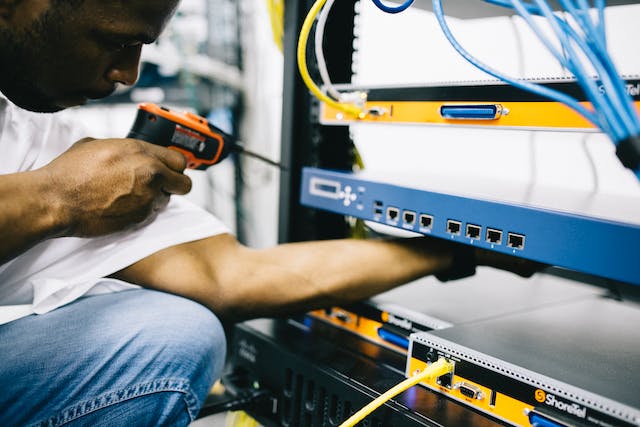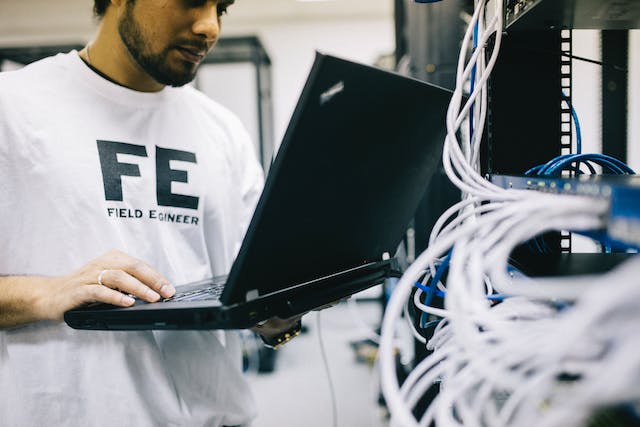Network Engineer Interview Questions with Answers

Network Engineer interview questions focus on assessing the candidate’s ability to maintain robust, functional, and efficient network systems. For hiring managers recruiting network engineers and job seekers preparing for interviews, knowing common questions is crucial. Below are key technical interview questions with simplified answers to help hiring managers assess candidates and job seekers prepare effectively.
What is a subnet mask?
Answer: It differentiates the network portion and host portion of an IP address.
Explain the difference between TCP and UDP.
Answer: TCP ensures reliable data transmission; UDP is faster but less reliable.
What is the purpose of VLAN?
Answer: VLANs segregate networks to improve performance and security without new hardware.
Describe what a firewall does in a network.
Answer: A firewall filters network traffic based on security rules.
What are the three-way handshake and its purpose in networking?
Answer: It establishes a reliable connection between two network devices.
How does a router differ from a switch?
Answer: Routers direct data between networks; switches manage data within one network.
What is the OSI model?
Answer: It’s a conceptual framework used to understand network interactions in seven layers.
What is NAT?
Answer: Network Address Translation (NAT) converts private IP addresses to public ones, allowing local devices to access the internet.
Explain what DNS is and how it works.
Answer: The Domain Name System (DNS) translates domain names to IP addresses, allowing browsers to load Internet resources.
What is a VPN?
Answer: A Virtual Private Network (VPN) extends a private network over a public one, allowing secure data transfer as if directly connected.
How do you secure a network?
Answer: Use firewalls, encrypt sensitive data, employ VLANs, and regularly update and patch systems.
Explain the concept of a default gateway.
Answer: A default gateway provides a routing path for a device to send traffic destined for an external network.
What is link aggregation?
Answer: Link aggregation combines multiple network connections in parallel to increase throughput and provide redundancy.
Describe the function of SNMP.
Answer: SNMP (Simple Network Management Protocol) manages devices on IP networks by monitoring them for issues needing attention.
What is an IP conflict, and how is it resolved?
Answer: An IP conflict occurs when two devices on the same network are assigned the same IP address. Resolving it typically involves setting static IP addresses or configuring the DHCP server to avoid duplicates.
Explain what traceroute does.
Answer: Traceroute is a network tool that tracks the path of a packet, identifying points of failure.
What is a loopback IP address?
Answer: A loopback IP address (127.0.0.1) tests network software by allowing a computer to communicate with itself without a NIC.
How does IPv6 differ from IPv4?
Answer: IPv6 offers a larger address space, simplified packet headers for efficient routing, and supports auto-configuration for easier networking.
What are the primary types of network topologies?
Answer: The main types are star, bus, ring, mesh, and hybrid, each defining the layout and interconnectivity of network devices.
What is QoS and why is it important?
Answer: Quality of Service (QoS) prioritizes network traffic, ensuring important data, like VoIP and streaming, gets higher priority.
Explain packet switching.
Answer: Packet switching divides data into packets, which are routed through a network based on the destination address contained in each packet.
What are network protocols?
Answer: Network protocols are formal standards and policies comprised of rules, procedures, and formats that define communication between two or more devices over a network.
How do you mitigate a DDoS attack?
Answer: Mitigating DDoS attacks involves deploying anti-DDoS hardware and software solutions, using robust network architecture, and implementing strong security policies.
What is BGP and how does it function?
Answer: Border Gateway Protocol (BGP) is used for routing Internet traffic between autonomous systems (ASes). It determines the best paths for data transfer based on available paths and policy rules.
How do you configure a router?
Answer: Configuring a router typically involves setting up IP addresses, enabling routing protocols, configuring interfaces, and setting access controls and other security parameters.
Explain the concept of multicasting.
Answer: Multicasting is the delivery of network information to a group of destinations simultaneously using the most efficient strategy to distribute the messages.
What is the purpose of HSRP?
Answer: Hot Standby Router Protocol (HSRP) provides high network availability by routing network traffic along alternate paths when the primary path is unavailable.
How do you prevent ARP spoofing?
Answer: ARP spoofing can be prevented by using dynamic ARP inspection, enabling DHCP snooping, and configuring static ARP entries where possible.
What is MPLS and what are its benefits?
Answer: Multiprotocol Label Switching (MPLS) is a routing technique that directs data from one node to the next based on short path labels rather than long network addresses, reducing the complexity of lookups in a routing table and improving speed.
Explain the differences between symmetric and asymmetric encryption.
Answer: Symmetric encryption uses the same key for both encryption and decryption, whereas asymmetric encryption uses a pair of public and private keys for encryption and decryption.
Describe what a DMZ is and its purpose.
Answer: A Demilitarized Zone (DMZ) is a physical or logical subnetwork that contains and exposes an organization’s external-facing services to an untrusted network, typically the Internet.
What are ACLs?
Answer: Access Control Lists (ACLs) are a set of rules that control network traffic and limit access to networks by allowing or denying traffic based on IP addresses, protocols, ports, etc.
How do network masks work?
Answer: Network masks segment an IP address into the network and host addresses, allowing different networks to be identified and managed.
What is the difference between a hub, a switch, and a router?
Answer: A hub broadcasts data to all devices on a network, a switch sends data only to the destination device, and a router directs data between different networks.
Explain the role of a network engineer in cybersecurity.
Answer: Network engineers design secure networks, implement security measures like firewalls and encryption protocols, and monitor network activity to detect and respond to security breaches.
What is the function of STP in network design?
Answer: Spanning Tree Protocol (STP) prevents network loops in Ethernet networks, which are critical for maintaining a loop-free network topology.
Explain the difference between LACP and PAgP.
Answer: Both LACP (Link Aggregation Control Protocol) and PAgP (Port Aggregation Protocol) are protocols used to bundle several physical ports to form a single logical channel. LACP is an open standard, while PAgP is Cisco proprietary.
How does SSL/TLS work?
Answer: SSL/TLS protocols encrypt the segments of network connections at the Transport Layer, providing secure end-to-end communications by encrypting data in transit.
What is network slicing?
Answer: Network slicing is a type of virtual networking architecture within the same physical network, which allows multiple virtual networks to be created on top of a common shared physical infrastructure, often used in 5G networks.
Describe the role of ICMP in networking.
Answer: Internet Control Message Protocol (ICMP) is used by network devices to send error messages and operational information indicating, for example, that a requested service is not available or that a host or router could not be reached.
What is SDN?
Answer: Software-Defined Networking (SDN) is an approach to network management that enables dynamic, programmatically efficient network configuration to improve network performance and monitoring, making it more like cloud computing than traditional network management.
How do you implement QoS on a network?
Answer: Implementing QoS involves configuring network devices to recognize different types of traffic, prioritizing them as required, and ensuring that essential traffic gets bandwidth priority.
Explain the concept of IPsec.
Answer: IPsec is a suite of protocols for securing Internet Protocol (IP) communications by authenticating and encrypting each IP packet of a communication session.
What are the challenges of wireless networking?
Answer: Challenges include interference from other devices, security vulnerabilities, signal range limits, and bandwidth limitations compared to wired networks.
How does a content delivery network (CDN) work?
Answer: A CDN is a network of servers that deliver web content to a user based on the geographic locations of the user, the origin of the webpage, and a content delivery server.
What is network automation?
Answer: Network automation involves the use of software to automate the configuration, management, testing, deployment, and operations of physical and virtual devices within a network.
How can you reduce latency in a network?
Answer: Reducing latency can be achieved by optimizing network infrastructure, using faster hardware, implementing quality of service (QoS) features, and minimizing the distance data must travel.
Common Technologies Used by Network Engineers

Network engineers utilize a variety of technologies to design, implement, and maintain networks efficiently. Here are some of the most common ones:
- Routing and Switching – Essential for directing data in a network using devices like routers and switches.
- Firewalls and Security Appliances – Used to protect network data from unauthorized access and threats.
- Wireless Technologies – Includes Wi-Fi and other wireless systems to enable mobile networking.
- Network Protocols – Such as TCP/IP, BGP, OSPF, and MPLS, which govern data transmission across networks.
- VPN (Virtual Private Network) – Secures remote connections to ensure data safety across public networks.
- VoIP (Voice over Internet Protocol) – Technology for delivering voice communications and multimedia sessions over IP networks.
- Network Management Software – Tools like SolarWinds, Nagios, and Wireshark for monitoring network performance and troubleshooting issues.
- Cloud Services – Such as AWS, Azure, and Google Cloud, which are increasingly integral for modern network architectures.
- SDN (Software Defined Networking) – Enhances network management and efficiency with software-based control.
- IPv6 – The latest version of the Internet Protocol that provides an identification and location system for computers on networks and routes traffic across the Internet.
Key Expertise Areas for Network Engineers
Network engineers require a diverse set of skills and expertise to effectively manage and improve network infrastructures. Here are some common areas of expertise that are crucial in this field:
- Network Design and Architecture – Planning and designing scalable, reliable, and efficient networks.
- Troubleshooting and Problem Solving – Quickly identifying and resolving network issues to minimize downtime.
- Security Measures – Implementing and managing security protocols like firewalls, intrusion detection systems, and encryption.
- Data Center Management – Overseeing the operation of servers, data storage, and network resources in data centers.
- Cloud Computing – Utilizing cloud platforms for network operations, including cloud migrations and configurations.
- Network Monitoring and Analytics – Using software tools to monitor network performance and analyze traffic patterns.
- Wireless Technologies – Designing and managing wireless networks, including Wi-Fi and mobile communications.
- Protocol Configuration – Configuring and managing the implementation of communication protocols like TCP/IP, BGP, and OSPF.
- Virtualization Technologies – Employing virtualization tools and techniques to optimize network resources and operations.
- Regulatory Compliance – Ensuring networks comply with industry standards and government regulations.
Need to Hire Network Engineers?

If you’re looking to expand your team with skilled network engineers, Tier2Tek Staffing can connect you with top-tier talent efficiently and effectively. We specialize in understanding the specific needs and nuances of networking roles to find the perfect match for your organization.
- Sourcing Speed: Rapid techniques to quickly find qualified network engineers.
- Communication with Clients: We keep you in the loop throughout the hiring process.
- Quality Candidates: Only the best network engineers who match your criteria.
- Innovative Sourcing Strategies: Advanced methods to access a diverse talent pool.
